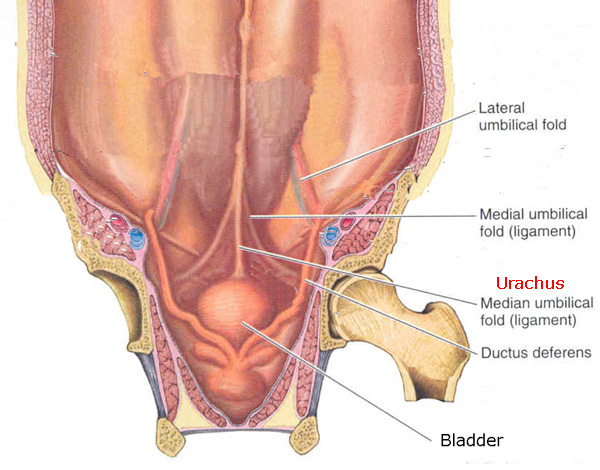Hereof what are the medial umbilical ligaments remnants of. What is urachal remnant in child.

Medial Umbilical Ligament Wikiwand
The median umbilical ligament has.

. It is a shrivelled piece of tissue that represents the remnant of the embryonic urachus. The median and medial umbilical ligaments form a peritoneal depression on each side of the urinary bladder referred to as the supravesical fossae. Click to see full answer.
The bilateral supravesical fossae lie between the median and bilateral medial umbilical folds. The median umbilical fold runs superiorly from the apex of the bladder to the umbilicus. It then becomes the urachus in the fetus.
The median umbilical ligament is a structure in human anatomy. The medial umbilical ligaments are paired structures related to the umbilical arteries found either side of the median umbilical ligament. It is seen to lie between the transversalis fascia and peritoneum.
It extends from the apex of the bladder to the umbilicus on the deep surface of the anterior abdominal wall. A double layer of peritoneum extending from one visceral organ to another. The median umbilical ligament begins as the allantois in the embryonic period.
The paired medial umbilical folds pass from the pelvis to the umbilicus and cover the underlying medial umbilical ligaments. It is different to the median umbilical ligament a structure that. The folds are 2 of the 5 umbilical folds and should not be confused with the single midline median umbilical fold.
It is important to distinguish between the medial vs median umbilical ligaments. Median medial lateral. The folds are 2 of the 5 umbilical folds and should not be confused with the single midline median umbilical fold.
Cordlike remnants of fetal tubular structures that are nonfunctional after birth. Urachal anomalies - if urachus doesnt close off completely. The median umbilical ligament runs down the lower portion of the front of the abdominal wall.
The urachus connects the dome of the bladder to the umbilical cord during fetal life and is located behind the abdominal wall and anterior to the peritoneum in the space of Retzius. It is different from the median umbilical ligament a structure that represents the. It is important to distinguish between the medial vs.
The medial umbilical ligaments are anatomical remnants of the obliterated foetal umbilical arteries. Males more than females rare-- failure of abdominal wall closing. The vertex of the bladder is joined to the umbilicus by the remains of the urachus which forms the middle umbilical ligament a fibromuscular cord broad at its attachment to the bladder but narrowing as it ascends.
Paired medial umbilical ligaments run along other side with a matching set of lateral ligaments. It is on the deep surface of the anterior abdominal wall and is covered by the medial umbilical folds. By birth the urachus is obliterated and becomes a vestigial structure known as the median umbilical ligament.
Accessory ligament one. Umbilical arteries - basically know that they are different. The supravesical fossa is the area of abdominal wall between remnant of urachus Median umbilical ligament and remnant of left or right umbilical artery medial umbilical ligament.
It is also formed from the cloaca in utero. This fold is formed by the underlying median umbilical ligament. The medial umbilical ligament is the aforementioned paired structure related to the umbilical arteries while the median umbilical ligament contains the urachus.
The remnants of an embryonic communication between the allantois and cloaca. The medial umbilical ligaments are anatomical remnants of the obliterated foetal umbilical arteries. The medial umbilical ligament is a paired structure found in human anatomy.
It is also known as the cord of the umbilical artery. It is on the deep surface of the anterior abdominal wall and is covered by the medial umbilical foldsplicae umbilicales mediales. The medial umbilical ligamentor cord of umbilical artery or obliterated umbilical artery is a paired structure found in human anatomy.
Lateral to this structure are the medial umbilical ligament and the lateral umbilical ligament. An umbilical cord is a thick blood-rich cord that connects a baby to its mother during the gestation process. Inguinal swelling due to rare external supravesical hernia--a case report.
Median umbilical ligament vs. A band of fibrous tissue connecting bones or cartilages serving to support and strengthen joints. It is a remnant of the fetal urachus.
Median umbilical ligament - Ligamentum umbilicale medianum. The medial umbilical ligament is an anatomic structure present in the human body that exists as a remnant of blood vessels that were important to fetal circulation. This later develops into the median umbilical ligament at birth.
Paired medial umbilical ligaments run along other side with a matching set of lateral ligaments. The median umbilical fold is a raised ridge of parietal peritoneum in the deep aspect of the anterior abdominal wall overlying the median umbilical ligament urachal remnant. This channel normally closes up as the fetus grows.
:background_color(FFFFFF):format(jpeg)/images/library/13444/BbSCSuvYy55YkvWLz75uw_Medial_umbilical_ligament__2_.png)
Medial Umbilical Ligament Anatomy Branches Supply Kenhub

Median Umbilical Ligament Wikipedia

Testpress Medical This Is One Of The Most Confusing Questions Asked In Embryology But For Those Who Can Spend Time To Understand It This Is For An Easy Retention And

Abdominal Wall Peritoneum And Intestines Lo 2 Abdominal Wall Youtube

Mcat Memoranda Umbilical Folds Median Medial And Lateral Are

Medial Umbilical Ligament Wikipedia

Median Umbilical Ligament Or Vesicourachal Diverticulum Journal Of Minimally Invasive Gynecology

0 comments
Post a Comment